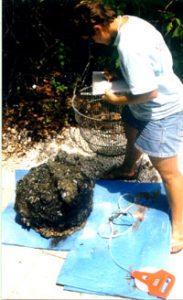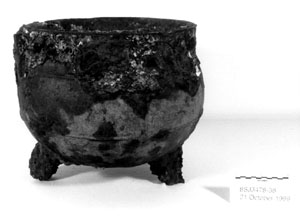CRL Reports: 8SJ3478 Industry – Cauldron
The Artifacts: The Cast Iron Cauldron 8SJ3478-38
 The iron cauldron was also uncovered by the prop wash deflectors. The cauldron lay approximately .50 meters below the datum, just below the southernmost edges of the anchors. After sampling contents in situ on the sea floor, the cauldron was recovered for conservation and analysis.
The iron cauldron was also uncovered by the prop wash deflectors. The cauldron lay approximately .50 meters below the datum, just below the southernmost edges of the anchors. After sampling contents in situ on the sea floor, the cauldron was recovered for conservation and analysis.
The image to the right shows the cauldron being recorded before mechanical cleaning. Note the concreted tool on the bottom of the kettle. After transportation to CRL in Texas, the cauldron underwent mechanical cleaning before being set up in a tank for electrolytic reduction.
Previous experience has shown that fragile cast iron objects often disintegrate during electrolytic reduction. This suggested that the prudent course of conservation would be to clean the exterior of the kettle only, which would allow the object to evolve during electrolysis, while the marine growth on the interior helped to maintain the integrity of the object. This also allowed careful documentation of the cauldron before electrolytic treatment was begun.  The left image is the cauldron after mechanical cleaning. Cauldron 8SJ3478-38 measures approximately 39 cm in overall height. The maximum outer diameter is 41 cm, and thickness is approximately 0.5 cm at the rim. One of the legs is missing, while the two remaining legs seem to be hollow and of differing heights. Three reinforce rings were observed around the outside of the cauldron.
The left image is the cauldron after mechanical cleaning. Cauldron 8SJ3478-38 measures approximately 39 cm in overall height. The maximum outer diameter is 41 cm, and thickness is approximately 0.5 cm at the rim. One of the legs is missing, while the two remaining legs seem to be hollow and of differing heights. Three reinforce rings were observed around the outside of the cauldron.
Citation Information:
Franklin, Marianne
2000, Site 8SJ3478, possibly the Industry: A British 18th-Century Shipwreck, Conservation Research Laboratory Research Report #10, World Wide Web,
URL, https://liberalarts.tamu.edu/nautarch/crl-reports-8sj3478-industry-cauldron/. Nautical Archaeology Program, Texas A&M University
